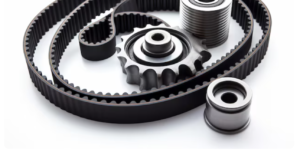
When it comes to the intricate machinery of an engine, timing belt pulleys play a crucial role in ensuring optimal performance. These components are often overlooked but are essential for the smooth operation of an engine, directly influencing its efficiency, power output, and longevity. In this article, we will delve into the importance of timing belt pulleys, their function, and how they contribute to the overall health of an engine.
What Are Timing Belt Pulleys?
Timing belt pulleys are wheel-like components that work in conjunction with the timing belt to synchronize the movement of the engine’s crankshaft and camshaft. The timing belt is a toothed belt that connects these two essential engine parts, allowing for precise timing of valve openings and closings. This synchronization is vital for the engine’s performance, as it ensures that fuel and air enter the combustion chamber at the right time, enabling efficient power generation.
How Timing Belt Pulleys Function
The operation of timing belt pulleys is relatively straightforward. As the crankshaft rotates, it turns the timing belt, which in turn rotates the camshaft via the timing belt pulleys. This rotational motion is critical; if the timing is off, it can lead to poor engine performance, increased emissions, or even catastrophic engine failure.
Timing belt pulleys come in various sizes and designs, each tailored to specific engine configurations. Some vehicles utilize multiple pulleys to manage the timing belt’s movement effectively. Proper alignment and tension of the timing belt around these pulleys are crucial; incorrect settings can lead to belt slippage or premature wear.
The Importance of Timing Belt Pulleys
- Engine Synchronization: The primary function of timing belt pulleys is to ensure that the crankshaft and camshaft operate in perfect harmony. This synchronization is vital for the engine to function efficiently. When the timing is accurate, it maximizes power output while minimizing fuel consumption.
- Performance Optimization: High-performance vehicles often rely on specially designed timing belt pulleys to improve engine responsiveness. These pulleys can be crafted from lightweight materials or feature advanced designs that reduce friction, allowing for quicker acceleration and smoother power delivery.
- Preventing Engine Damage: A malfunctioning timing belt pulley can lead to severe engine problems. If the timing belt slips or breaks due to pulley wear or misalignment, the engine’s valves may collide with the pistons, resulting in costly repairs. Regular inspection and maintenance of timing belt pulleys are essential to prevent such issues.
- Longevity of Engine Components: Properly functioning timing belt pulleys contribute to the longevity of the engine. By ensuring smooth operation and reducing strain on engine components, they help maintain overall engine health and reduce the likelihood of breakdowns.
Signs of Timing Belt Pulley Problems
Recognizing the signs of potential timing belt pulley issues is crucial for vehicle maintenance. Here are a few indicators to watch for:
- Unusual Noises: If you hear grinding or squeaking noises coming from the engine, it may indicate that the timing belt pulley is worn or damaged.
- Engine Performance Issues: A sudden decrease in engine power, misfiring, or stalling can be attributed to timing issues caused by faulty pulleys.
- Check Engine Light: If your vehicle’s check engine light illuminates, it’s wise to have the timing belt and pulleys inspected.
Maintenance Tips
To ensure your timing belt pulleys function effectively, consider the following maintenance tips:
- Regular Inspections: Have a qualified mechanic check your timing belt and pulleys during routine maintenance.
- Belt Replacement: Timing belts should be replaced according to the manufacturer’s recommendations, typically every 60,000 to 100,000 miles.
- Listen for Noise: Pay attention to any unusual sounds and address them promptly.
Conclusion
Timing belt pulleys are a fundamental component of an engine’s performance and reliability. By understanding their role and ensuring proper maintenance, you can help extend the life of your engine and enhance its performance. Whether you’re a car enthusiast or simply want your vehicle to run smoothly, paying attention to timing belt pulleys is an essential aspect of automotive care. Regular checks and timely replacements can save you from costly repairs and ensure that your engine continues to operate at its best.






